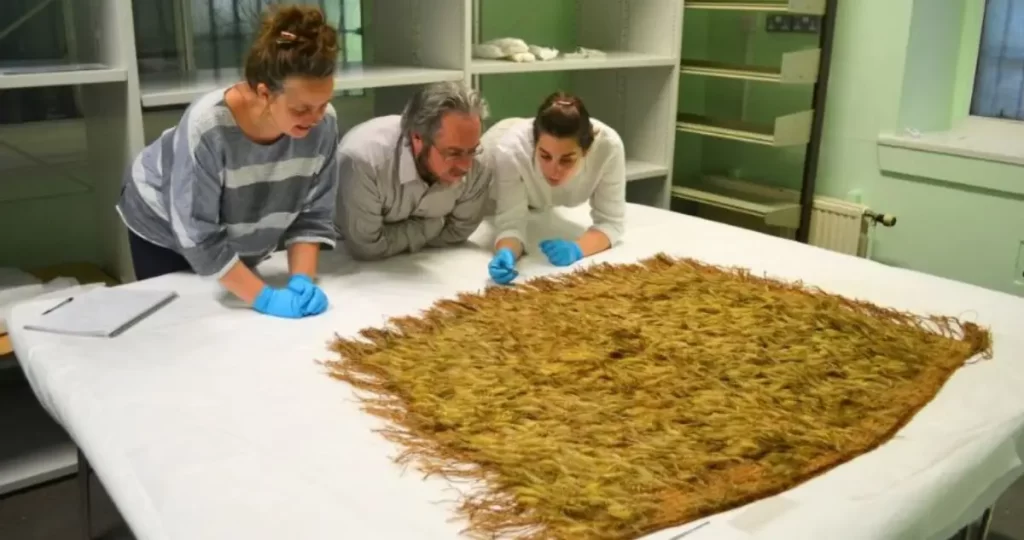More than a century’s worth of labor was invested in refurbishing the solitary known intact Māori kahu kākāpō, a customary cloak fashioned from the plumes of a scarce flightless parrot indigenous to New Zealand.
The singular surviving Māori kahu kākāpō, a customary cloak, presently adorns the Perth Museum and Art Gallery (PMAG) in Scotland. Composed of the plumes of New Zealand’s verdant kākāpō, the globe’s exclusive flightless parrot.
Following extensive refurbishment at the British Museum in London, the cloak is in outstanding condition and accessible for spectators to admire as a significant aspect of Māori heritage.

The Kahu Kākāpō In Māori Tradition The Māori populace of New Zealand boasts a rich tradition regarding the crafting of kākahu, customary cloaks fashioned from flax strands and plumes. Historically, the plumes were sourced from kiwis and kākāpō parrots, sizable flightless avians at times dubbed “moss chickens.”
The Māori created these cloaks for ceremonial use, exclusively donned by individuals of esteemed status and exceedingly rare.
Colonial settlers in New Zealand sometimes amassed these cloaks and transported them back to their homelands, as evidenced by the most recent kākahu to be exhibited.
In 1823, David Ramsay, a Scotsman who voyaged to Australia as a ship’s physician, fortuitously acquired this kahu kākāpō. Subsequently, in 1842, he bestowed it upon the Perth Literary and Antiquarian Society, where it remained for over a century.
Recently, the newly inaugurated Perth Museum collaborated with the British Museum to meticulously rejuvenate the cloak, now the sole known complete kahu kākāpō in existence.

Rejuvenating The Māori Cloak In 2022, the Perth Museum and Art Gallery reached out to the British Museum regarding the kahu kākāpō. The museum aimed to showcase the artifact but harbored concerns about its fragility. They sought assistance in rectifying the cloak for exhibition during their spring 2024 unveiling.
At the British Museum, scholars scrutinizing the cloak estimated that Māori artisans fashioned the attire in the early 1800s post the arrival of Europeans in New Zealand.
Prior to the cloak’s arrival at the British Museum, Māori representatives journeyed to Perth to conduct rituals with the cloak, encompassing invocations for its safe transit to London, vocal performances, and dialogues on Māori traditions with scholars and museum personnel.
Subsequently, the cloak arrived in London, and refurbishment commenced. Restorers collaborated with a Māori consultant to ensure adherence to appropriate cultural protocols.

Initially, conservators utilized mulberry paper to reinforce the bent and detached plumes on the cloak. The pōkinikini, or flax strands within the cloak, also necessitated prompt attention. As per the British Museum’s press release, the original craftsmen likely dyed the strands with iron-tannin dye which gradually compromised their integrity over time. Restorers also applied mulberry paper to these strands to provide reinforcement.
Subsequently, researchers endeavored to ascertain how the cloak was traditionally worn to facilitate proper exhibition. Diligent examination of the garment unveiled that it would have been affixed at the right shoulder. Following this revelation, the museum fashioned a bespoke mount to exhibit the cloak akin to Māori customs.
In totality, more than 100 hours of labor were expended in refurbishing the cloak, often necessitating the utilization of precision tools under magnification.
Additionally, the presence of kākāpō plumes prompted the conservation team to dispatch DNA specimens to researchers spearheading conservation endeavors for the imperiled flightless bird.
“It has been an immense honor for us at Perth Museum and Art Gallery and the British Museum to contribute to the conservation of this captivating and enduring taonga (cultural heritage) and to facilitate the kahu’s secure transition into the future,” articulated the British Museum.
As of March 30, 2024, the kahu is officially on display at the Perth Museum and Art Gallery.



